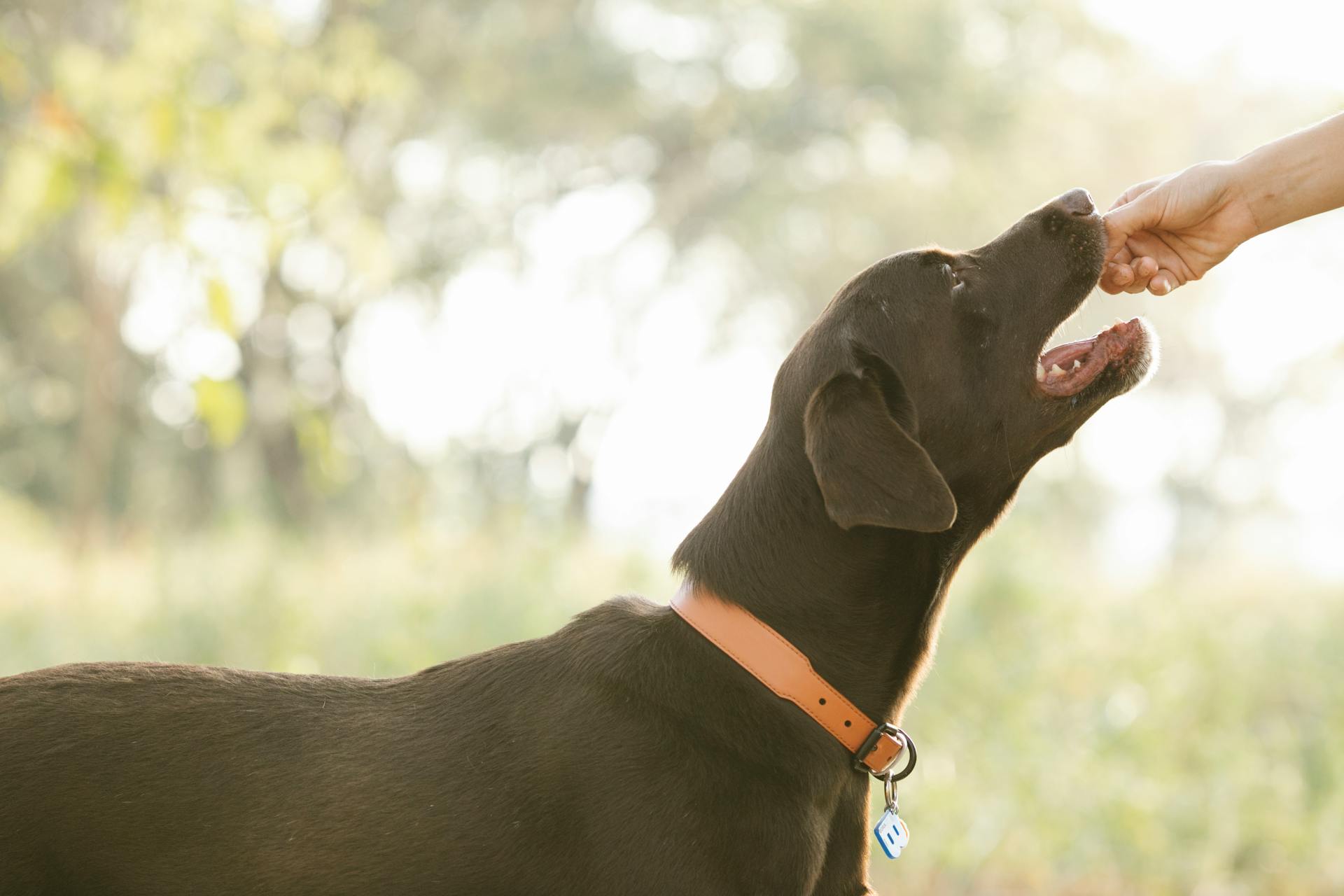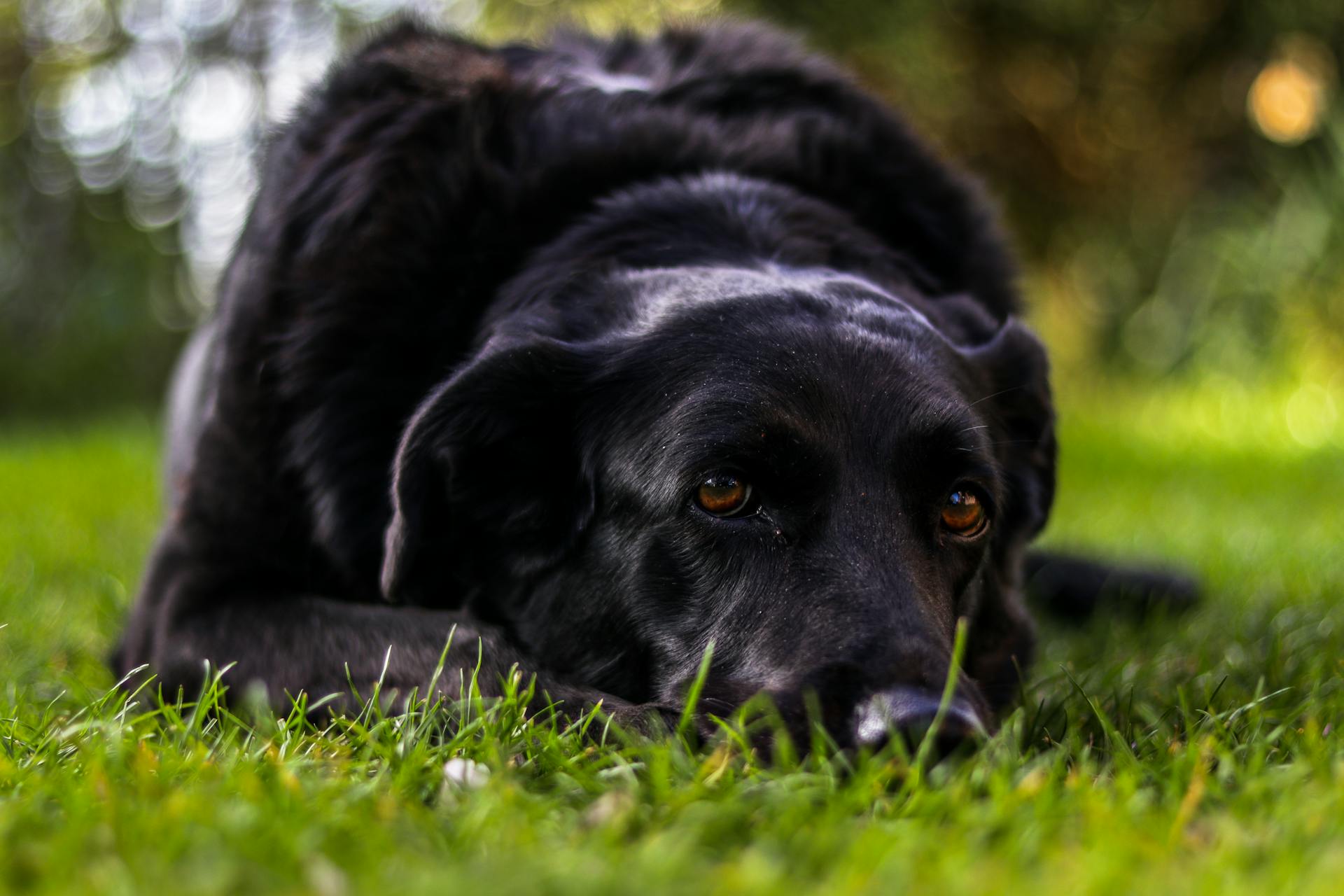
Labradors are one of the most popular breeds in the world, and it's easy to see why. They're known for their friendly, outgoing personalities and their high intelligence.
Labradors are a medium to large breed, typically weighing between 55 and 80 pounds. They have a short, dense coat that requires regular grooming.
Their friendly nature makes them a great breed for families with children, as they're patient and gentle.
Check this out: Why Are Labradors so Friendly
Breed Characteristics
Labradors are known for their friendly and outgoing personalities. They are often described as "velcro dogs" because of their tendency to stick close to their family members.
Their high energy levels mean they require regular exercise to stay happy and healthy. A daily walk and some playtime should do the trick.
Their short coats require minimal grooming, making them a great choice for busy owners.
Size
Labrador Retrievers are a medium to large breed, with males standing between 22.5 to 24.5 inches tall.
These dogs can weigh quite a bit, with males tipping the scales at 65 to 80 pounds.
Females are slightly smaller, standing between 21.5 to 23.5 inches tall, and weigh between 55 to 70 pounds.
Coat Color and Grooming
The Labrador Retriever's coat is a two-layered marvel, with a short, thick topcoat and a soft, weather-resistant undercoat. This unique combination protects them from the cold and wet, making them perfect for their role as retrievers.
Their coat comes in three main colors: chocolate, black, and yellow. Black was the favorite color among early breeders, but yellow and chocolate Labs have gained popularity over the years.
Labradors shed a lot, so be prepared to vacuum frequently and brush your dog daily, especially during shedding season. A quality vacuum cleaner is a must-have for any Lab owner.
If your Lab gets dirty, it's fine to bathe them more often than every two months. Just remember to brush their teeth regularly to prevent tartar buildup and bad breath.
Daily brushing is even better, and trimming their nails once or twice a month will keep their feet in good condition and prevent scratched legs. If you can hear their nails clicking on the floor, they're too long.
For your interest: Dog Brush for Labrador
Their ears need regular checking for redness or a bad odor, which can indicate an infection. Wipe them out with a cotton ball and gentle ear cleaner to help prevent infections.
Regular grooming from a young age will make your Lab more comfortable with being handled and examined, making future vet visits a breeze.
Health and Care
Labradors need regular exercise to stay happy and healthy. Daily 30-minute walks, a romp at the dog park, or a game of fetch are a few ways to help your Lab burn off energy.
It's essential to remember that Lab puppies shouldn't be taken for too long walks and should play for a few minutes at a time, as they can exhaust themselves quickly. They'll thank you for it later.
Some common health problems that Labradors may encounter include joint problems, such as hip or elbow dysplasia, ear infections, heart disease, and bloat.
Consider reading: Chocolate Lab Problems
Health Needs
Labrador Retrievers are prone to joint problems, such as hip or elbow dysplasia, which can be painful and limit their mobility.

Regular exercise and a healthy weight can help prevent or alleviate joint problems in Labradors. However, it's essential to avoid overexertion, especially in young dogs.
Labradors are also susceptible to ear infections, which can be caused by bacterial or yeast infections.
To prevent ear infections, it's crucial to clean your Labrador's ears regularly and check for signs of infection, such as redness, swelling, or discharge.
Labradors can also be affected by heart disease, which can be a serious condition if left untreated.
Here are some common health problems that Labradors may encounter:
- Joint problems (hip or elbow dysplasia)
- Weight problems
- Ear infections
- Heart disease
- Bloat
Bloat is a life-threatening condition that requires immediate veterinary attention. If you suspect your Labrador has bloat, it's essential to seek help right away.
Feeding
Feeding your Labrador Retriever is crucial for their overall health and well-being.
A good quality dog food is essential, and the recommended daily amount is 2.5 to 3 cups of high-quality dry food a day, divided into two meals.
Worth a look: Labradors and Food

Your dog's individual needs depend on their size, age, build, metabolism, and activity level, so it's essential to monitor their food intake and adjust accordingly.
A highly active dog will need more food than a couch potato dog, and the quality of the dog food makes a significant difference.
Measuring your dog's food and feeding them twice a day rather than leaving food out all the time is a good practice.
To check if your dog is overweight, give them the eye test and the hands-on test: you should be able to see a waist, and feel but not see their ribs without having to press hard.
If you can't feel their ribs, they need less food and more exercise.
Lab puppies grow rapidly between four and seven months, making them susceptible to bone disorders, so it's essential to feed them a high-quality, low-calorie diet to prevent overgrowth.
Check this out: Why Are Labrador Retrievers so Popular
Care
Labrador Retrievers need to be around their family and are not suited for being a backyard dog. They'll likely get bored and destructive if left alone for too long.

Daily 30-minute walks, a romp at the dog park, or a game of fetch are great ways to help your Lab burn off energy. You should also consider a puppy's age and not take them on too long walks.
Labrador Retrievers are known to be "workaholics" and will exhaust themselves if not given regular breaks. It's essential to end play and training sessions before they get too tired.
Training is crucial for Labrador Retrievers, and they take to it well, often excelling in obedience competitions. They're best taught with positive training methods that reward good behavior.
Lab puppies need special care to prevent joint damage. Avoid letting them run and play on hard surfaces like pavement until they're at least two years old.
Labrador Retrievers love to carry things in their mouth and are natural chewers. Make sure to provide sturdy toys to keep them occupied and prevent damage to your belongings.
Training and Behavior
Labradors are highly trainable due to their intelligence and eagerness to please, making them a great choice for first-time dog owners.
They thrive on activity, both physical and mental, so be prepared to provide regular exercise and mental stimulation to keep them happy and healthy.
Training is essential from an early age, especially when it comes to leash training, as they can become very strong and stubborn if not taught properly.
Labradors are generally good-natured and loving, but may be wary of strangers unless socialized at a young age, so it's essential to socialize them well to ensure they grow into confident and friendly adult dogs.
With early obedience training and consistent reinforcement, Labradors can become well-behaved and loyal companions, making them a fantastic addition to any family.
A fresh viewpoint: Why Do Labradors Shed so Much
Trainability
Labrador Retrievers are known for being easy to train due to their intelligence and eagerness to please. This breed thrives on activity and mental stimulation, making them highly trainable.
Their outgoing and friendly nature means they're quick to learn and respond to commands. With early obedience training, Labs can become well-behaved companions.
Labs have a lot of energy and exuberance, which can sometimes be misdirected if they don't receive enough physical and mental activity. This is why consistent training and exercise are essential to keep them happy and well-behaved.
Their willingness to please and adapt to new situations makes them a joy to train. As a result, they're often used as guide dogs, search and rescue dogs, and therapy dogs.
Early socialization is key to helping Labs become confident and calm in the presence of strangers. This is especially important for a breed that can be wary of new people and situations.
By teaching Labs not to pull on their leash from an early age, you can prevent unwanted behavior and strengthen your bond with your dog.
Here's an interesting read: Lab Family Dog
Exercise Needs
Exercise is essential for your Labrador Retriever's overall health and happiness. They need daily exercise to stay physically and mentally stimulated.
Labradors love to swim, so if you have access to a pool or a lake, this can be a great way to get them moving. However, swimming alone is not enough to meet their exercise needs.
Daily long walks or jogs are a must, as well as regular romps and runs. A fenced yard can also provide a safe space for your Labrador to run around and play.
Frequently Asked Questions
What are the pros and cons of a Labrador?
Labradors are friendly, intelligent, and trainable, but may be more independent and stubborn than some breeds. They make great companions for active families, but may require patient and consistent training.
What is the calmest breed of Lab?
English Labs are generally considered the calmest breed of Lab, bred for their gentle nature and often used as therapy and service dogs.
Are Labradors low maintenance?
Yes, Labradors are considered a relatively low-maintenance breed despite their high energy levels and shedding. However, their needs still require attention and care.
Why Labrador is expensive?
Labrador prices are influenced by the breeder's reputation and investment in the puppies' health, nutrition, and socialization. Reputable breeders charge more for their puppies due to these added costs.
Do Labrador Retrievers bark a lot?
Labradors are generally not excessive barkers, but they may bark to alert their owners, seek attention, or during play. If well-trained, they tend to bark with purpose rather than habit.
Sources
- https://dogtime.com/dog-breeds/labrador-retriever
- https://www.countryliving.com/uk/wildlife/dog-breeds/a33346390/labrador-retrievers/
- https://www.bil-jac.com/breed-library/labrador-retriever/
- https://www.theguardian.com/commentisfree/2016/feb/23/open-thread-labradors-are-they-really-the-best-dogs-ever
- https://www.countrylife.co.uk/out-and-about/dogs/country-lifes-favourite-dogs-labrador-3102
Featured Images: pexels.com


